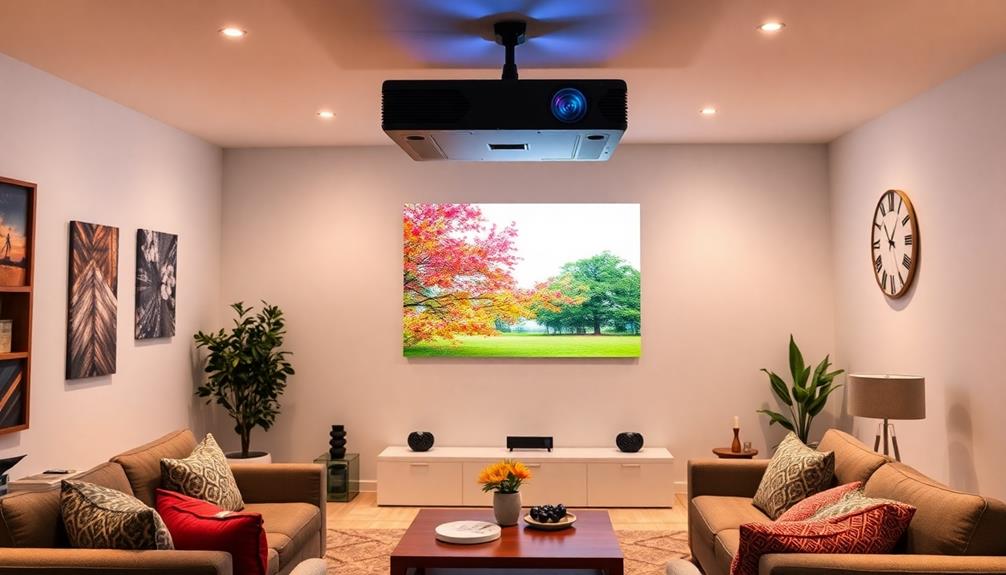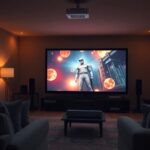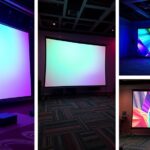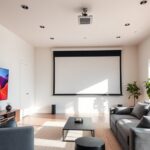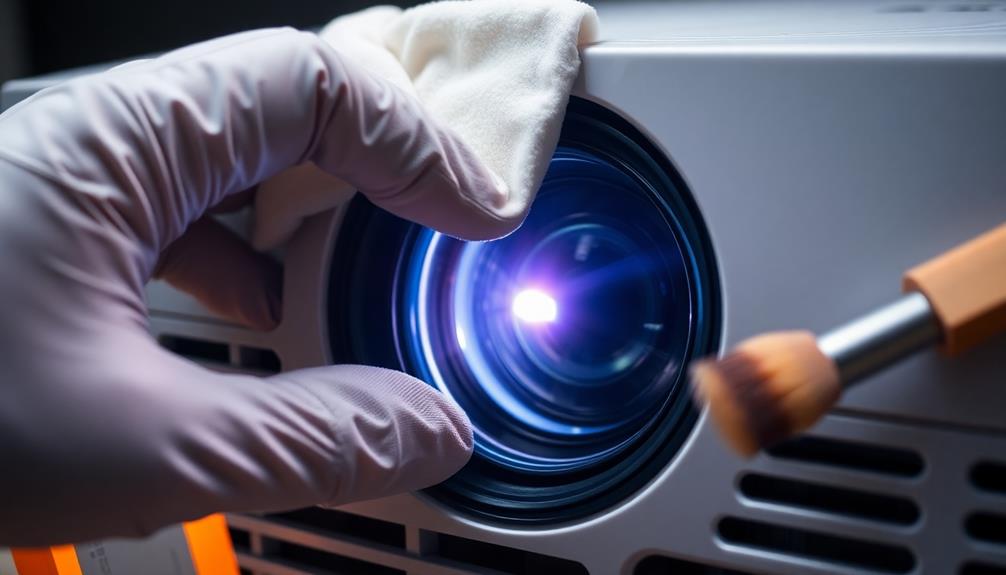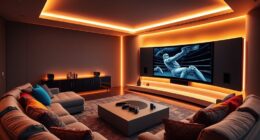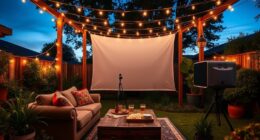Choosing the right projector screen can transform your viewing experience. You'll find various types, from fixed frame to retractable, each serving unique needs. Sizes matter too; make sure to pick one that suits your room and viewing distance for maximum enjoyment. Consider the aspect ratio that fits your content, as well as the material—matte white, high contrast gray, or acoustically transparent options may be best depending on your environment. Each choice impacts image quality and immersion. Stay with us to explore the specifics that can help you make an informed decision for your home or business setup.
Key Takeaways
- Projector screens enhance image quality and contrast compared to walls, making proper selection crucial for optimal viewing experiences.
- Types of screens include fixed frame, retractable, and specialized options like ALR and UST screens, each suited for different environments.
- Screen size should be determined by viewing distance, with recommendations suggesting 1.2 to 1.6 times the screen size for optimal enjoyment.
- Aspect ratios, such as 16:9 and 2.35:1, affect the viewing experience and should align with projector capabilities and content types.
- Screen materials vary, including matte white and high contrast gray, impacting color reproduction, brightness, and compatibility with different lighting conditions.
Importance of Projector Screens

When it comes to enjoying movies or presentations, a good projector screen is indispensable for achieving stunning image quality. Projector screens greatly enhance image quality compared to projecting onto walls, improving contrast, resolution, and color accuracy. This boost in quality directly elevates your viewing experience, making every detail pop.
Additionally, selecting the right screen can contribute to the role of contrast ratio in projector image quality, further enhancing the clarity of your visuals.
Proper selection of screen material and size is essential for ideal viewing. If you're in a brightly lit room, consider ambient light rejecting screens, which minimize light interference and maintain image fidelity. For larger spaces, opting for a larger screen can make a noticeable difference. The minimal price difference between sizes often justifies the upgrade, allowing you to immerse yourself in the cinematic experience.
Understanding your projector's specifications, including throw distance, brightness, and aspect ratio support, is important. This guarantees compatibility and ideal performance, allowing you to make the best choice for your home theater setup.
Types of Projector Screens

When choosing a projector screen, you'll mainly encounter fixed frame screens and retractable options.
Fixed frame screens deliver a smooth surface perfect for dedicated setups, while retractable screens offer versatile designs that can be easily stored away.
Understanding these types will help you find the right fit for your space and viewing needs.
Additionally, considering factors such as smart capabilities can enhance your overall viewing experience by integrating technology into your setup.
Fixed Frame Screens
Fixed frame screens offer a sleek and permanent solution for anyone looking to create an immersive home theater experience.
These screens provide a smooth projection surface, making them ideal for dedicated home theaters or dark rooms. With consistent tension across the screen material, you'll enjoy enhanced image quality that captivates your audience. Additionally, investing in high-quality equipment, much like the durability and efficiency seen in wood-burning stoves, can greatly enhance your overall viewing experience.
You can choose from standard and ambient light rejecting (ALR) varieties. The ALR screens are particularly beneficial in brighter environments, as they reflect less ambient light, ensuring your images remain vibrant.
Surrounding these fixed frame screens is a black velour border that enhances perceived contrast while eliminating light spill from the edges, further boosting your viewing experience.
Keep in mind that installation requires dedicated wall space and can be more complex than with other screen types. However, the investment pays off, especially for larger installations.
Fixed frame screens come in various screen sizes, often exceeding 180 inches diagonally, providing a cinematic experience that surpasses most large TVs. If you're serious about home theater quality, fixed frame screens are a perfect choice.
Retractable Screen Options
How do you balance aesthetics and functionality in your home theater setup? Retractable screens offer the perfect solution. You can choose between pull-down screens, which mount on the ceiling or wall, and pull-up screens that integrate into furniture for a seamless look.
If convenience is your priority, consider motorized retractable screens that you can control with a remote. For a more budget-friendly option, manual pull-down screens are a great choice.
Tab tensioned retractable screens are ideal when you want a perfectly flat surface during projection. They maintain consistent tension, minimizing imperfections and enhancing image quality.
Plus, their flexibility makes them perfect for multi-purpose rooms, where you can hide the screen when it's not in use.
Installation is generally simpler than fixed frame screens, allowing for easier adjustments in various room configurations.
Whether you're setting up a dedicated home theater or adapting your living space, retractable screens can help you achieve the right balance between style and functionality.
With so many options available, you're sure to find a solution that fits your needs and enhances your viewing experience.
Screen Size and Viewing Distance

Choosing the right screen size and viewing distance is essential for an enjoyable viewing experience.
You'll want to position your seating based on the screen dimensions to achieve that perfect cinematic feel.
Let's explore how to determine ideal screen dimensions and best viewing distances for your setup.
Optimal Screen Dimensions
When it comes to ideal screen dimensions, finding the right balance between screen size and viewing distance can greatly enhance your viewing experience. The best screen size is determined by your projector's throw distance and room dimensions.
For a standard experience, aim for a viewing distance that's 1.2 to 1.6 times the screen size. According to SMPTE guidelines, a 30° field of view is comfortable, while THX recommends a more immersive 40° field of view.
For example, if you have a 100-inch HDTV screen, the recommended viewing distance is about 11 feet; for a 200-inch screen, it jumps to around 22 feet.
You'll also want to take into account aspect ratios—16:9 is standard for most content, while 2.35:1 provides a wider cinematic experience for movies.
Larger screens can greatly improve your experience, and since the price difference is often minimal, opting for a larger screen is advisable if your space allows.
Ideal Viewing Distance
Finding the ideal viewing distance is essential for maximizing your enjoyment of any projector setup. To achieve an immersive cinematic experience, you should sit about 1.2 times the screen size away for a 30° field of view, or 1.6 times for a standard experience. For instance, if you have a 100-inch HDTV screen, your ideal viewing distance is roughly 11 feet, while a 200-inch screen requires about 22 feet.
SMPTE guidelines suggest maintaining that 30° viewing angle, but if you want a more engaging experience, consider THX recommendations, which advocate for a wider 40° angle.
Additionally, your projector screen size affects screen height—especially for 16:9 screens, where the height should equal 1/3 of the distance to your best seat.
Be cautious of mismatched aspect ratios; using a 4:3 projector on a 16:9 screen can lead to unsightly dead space on the sides, detracting from your viewing pleasure.
Aspect Ratios Explained

Understanding aspect ratios is essential for getting the most out of your projector experience. An aspect ratio defines the proportional relationship between a screen's width and height, and common formats include 4:3, 16:9, and 2.35:1.
The 16:9 aspect ratio is the standard for most modern displays, perfect for home theaters, gaming, and broadcasting. It's compatible with HD resolutions like 720p and 1080p, ensuring a crisp viewing experience.
On the other hand, the 4:3 aspect ratio is largely outdated but was once common for older TVs and projectors, mainly used for standard-definition video and presentations.
If you're a film buff, you might appreciate the cinematic 2.35:1 aspect ratio, which enhances immersion with its wider format, ideal for dedicated home theaters.
To achieve the best image quality, make sure your projector matches the native aspect ratio of your content. Otherwise, you risk facing letterboxing or cropping, which can detract from the overall viewing experience.
Selecting the right aspect ratio based on your screen size and content type can greatly elevate your projection enjoyment.
Projector Screen Materials

Selecting the right aspect ratio sets the stage for an enjoyable viewing experience, but the choice of projector screen material can greatly impact image quality as well. When it comes to screen materials, you've got several options to evaluate.
Matte white screens are versatile and cost-effective, providing excellent color reproduction in controlled lighting, making them ideal for home theaters and business presentations.
If your setup has some ambient light, high contrast gray screens can enhance black levels and perceived contrast, working well with high-lumen projectors.
For those aiming for immersive audio experiences, acoustically transparent materials let sound pass through, allowing speakers to be positioned behind the screen without sacrificing audio quality.
You should also pay attention to gain ratings, which indicate how much light a screen reflects back to viewers. Neutral gain screens are typically rated at 1.0 for even light reflection, while high-gain options can boost brightness but might limit ideal viewing angles.
Finally, specialized materials like Airbright 3D are designed for specific uses like 3D projection, offering high gain but with reduced versatility for general use.
Choose wisely to enhance your viewing experience!
Specialized Screen Options

When it comes to specialized screen options, you'll discover a variety of choices tailored to specific needs and environments.
For instance, rear projection screens are perfect for commercial applications where space is limited, allowing projectors to be placed behind the screen. These screens come in translucent and opaque finishes, providing flexibility based on your setup.
If you're looking for a more immersive home theater experience, acoustically transparent screens let sound pass through, enabling speaker placement behind the screen without compromising audio quality.
Ultra Short Throw (UST) screens are engineered to work with short-throw projectors, making them ideal for tight spaces where you want to project large images without shadows interfering.
Additionally, Ambient Light Rejecting (ALR) screens enhance image quality in brightly lit rooms by reflecting projector light while absorbing ambient light, which is particularly beneficial for multi-purpose areas.
With these specialized screen options, you can easily find a solution that fits your room size, desired screen surface, and specific aspect ratio, ensuring your projection systems deliver the best visual experience possible.
Factors Influencing Material Choice

Choosing the right material for your projector screen hinges on several key factors that can greatly affect your viewing experience.
First, consider room lighting; brighter environments often require high-gain screen materials to maintain ideal image quality. If you're in a space with varying light conditions, this will be vital for clear visuals.
Next, think about the audience size. For group settings, materials that support wide viewing angles are essential to guarantee everyone sees a clear picture.
The type of projector you use also plays a significant role in your material choice; different technologies like DLP or LCD may perform better with specific screen materials.
Your resolution needs can't be overlooked, either. High-definition content demands screens that can support finer detail for clarity, so choose accordingly.
Finally, if you're using sound systems, consider acoustic transparency. Specialized screen materials allow sound to pass through without compromising audio fidelity, enhancing your overall experience.
Practical Applications of Screens

Projector screens serve a variety of practical applications that can enhance your viewing experience, whether you're hosting a movie night or delivering a business presentation.
The right screen material and size can make all the difference in your setup. Here are some key applications to take into account:
- Home Theater: A matte white screen is versatile for controlled lighting, providing excellent color reproduction.
- Business Presentations: High contrast gray screens improve black levels and perceived contrast, making them ideal for spaces with ambient light.
- Acoustic Setups: Acoustically transparent screens let sound pass through, allowing speakers to be placed behind the screen for best sound quality.
When selecting a screen, take into account durability, especially in high-traffic areas like schools.
Fiberglass-backed screens reduce wrinkles and waves, ensuring reliable performance.
For outdoor movie nights, perforated vinyl screens balance sound quality and durability, while also being easy to clean.
Frequently Asked Questions
What Material Is Best for a Projector Screen?
When choosing a projector screen material, consider your environment. For controlled lighting, matte white works best. If there's some ambient light, high contrast gray enhances contrast. Acoustically transparent is great for immersive setups with speakers behind the screen.
What Are the Different Types of Projector Screens?
You've got a few options for projector screens: fixed frame and retractable. Fixed frame screens are stable and flat, while retractable ones offer flexibility with pull-down and pull-up varieties for your convenience.
What Are the List of Projector Screen Sizes?
When choosing a projector screen, you'll find sizes ranging from 42.5 inches to over 180 inches diagonally. The average home theater screen typically falls between 100 and 120 inches, perfect for immersive viewing experiences.
How Do I Know What Size Projector Screen I Need?
Imagine a movie night where everyone's comfortably engrossed. To choose your ideal projector screen size, measure your viewing distance, consider your projector's specs, and decide on the aspect ratio that matches your cinematic dreams.
Conclusion
To sum up, choosing the right projector screen isn't just about aesthetics; it greatly impacts your viewing experience. Think of it this way: a high-quality screen can elevate your movie nights or presentations to new heights, making colors pop and details sharper. Whether you're going for a portable option or a fixed frame, understanding the types, materials, and sizes helps you make an informed choice. So, immerse yourself and transform your space into a cinematic haven!
Hi, I’m Dominique. I love movies and want everyone to have the best home cinema experience possible. That’s why I started 1home Theatre Projector. We help people build their home cinema system using the latest technology and news on laser tv and all-around home entertainment.
We’re a small team of movie buffs (and experts) who are passionate about giving our readers the best advice and information possible. So whether you’re just starting out or you’re looking to upgrade your home cinema system, we’ve got you covered!

